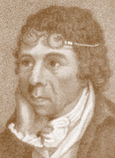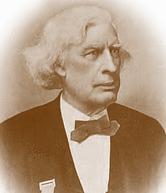Significant Developments and Changes in
|
|
The problem was, these landmarks were not defined in any manner. Dr Albert Mackey made the first attempt to do so in his Jurisprudence of Freemasonry of 1856, by laying down three requisite characteristics: notional immemorial antiquity, universality, and absolute "irrevocability". Mackey claimed there were 25 Landmarks, and they could not be changed, but other Masonic writers did not fully agree that all these should be considered “Ancient Landmarks.” In 1863, George Oliver published the Freemason's Treasury in which he listed 40 Landmarks. Still, others claimed different sets and numbers.
For this reason, Grand Lodges around the world differ in their interpretation and adoption of landmarks. There are Grand Lodges that acknowledge the existence of Landmarks but do not name them. |
Mackey's 25 Landmarks may be summarized into four groups:
1. Landmarks 1-3, 9, 11, 18-24 concern the Fraternity and the essence of the
Craft
2. Landmarks 4-8 refer to the Grand Master and his rights
3. Landmarks 12-15, 17 concern the rights of a Brother
4. Landmarks 10, 16 are those concerning the duties of a Lodge, including inter-
relations among Lodges
Since the validity of some of these Landmarks are in question, Landmark 25 has become contentious. It reads: Landmark 25: “The last and crowning Landmark of all is that these Landmarks can never be changed. Nothing can be subtracted from them-nothing can be added to them-not the slightest modification can be made in them. As they were received from our predecessors, we are bound by the most solemn obligations of duty to transmit them to our successors. Not one jot or one title of these unwritten laws can be repealed; for in respect to them, we are not only willing but compelled to adopt the language of the sturdy old barons of England.”
Roscoe Pound (1870-1964), former dean of Harvard Law School; HPGM, Grand Lodge of Nebraska, disagreed with Mackey. He excluded among others, Mackey’s landmarks that deal with the Grand Lodge and the Grand Master, and listed down only seven:
1. Belief in a Supreme Being
2. Belief in a persistence of personality
3. A "book of law" as an indispensable part of the "furniture" (or furnishings) of
the Lodge
4. The Hiramic legend of the Third Degree
5. Secrecy (modes of recognition)
6. The symbolism of the operative art
7. That a Mason be a man, freeborn, and of age.
Pound cited John S. Simons who defined Landmarks as; “those principles of action which have existed from time immemorial, whether in the written or unwritten law; which are identified with the form and essence of the society; which the great majority agree, cannot be changed, and which every mason is bound to maintain intact under the most solemn and inviolable sanctions".
The interpretation of a landmark is crucial in the formulation of a grand lodge constitution; that is why some jurisdictions are careful not to name all these Landmarks. RW Bro. Daniel Doron of the Grand Lodge of the State of Israel, in 2002 advanced this opinion:
“When we examine the twenty-five Landmarks of Mackey, it becomes clear, which landmarks express the quintessence of Freemasonry and which express structural aspects only. If we accept Simons' definition of landmarks, it is quite obvious that those landmarks which deal only with Grand Master and Grand Lodge cannot be from time immemorial. After all, these could not exist before 1717. Furthermore, they have nothing to do with a System of Morality. The same applies to any landmark concerning the third degree. Although the Hiramic legend is very old, the tri-gradal system was created only around 1730.”
Craft
2. Landmarks 4-8 refer to the Grand Master and his rights
3. Landmarks 12-15, 17 concern the rights of a Brother
4. Landmarks 10, 16 are those concerning the duties of a Lodge, including inter-
relations among Lodges
Since the validity of some of these Landmarks are in question, Landmark 25 has become contentious. It reads: Landmark 25: “The last and crowning Landmark of all is that these Landmarks can never be changed. Nothing can be subtracted from them-nothing can be added to them-not the slightest modification can be made in them. As they were received from our predecessors, we are bound by the most solemn obligations of duty to transmit them to our successors. Not one jot or one title of these unwritten laws can be repealed; for in respect to them, we are not only willing but compelled to adopt the language of the sturdy old barons of England.”
Roscoe Pound (1870-1964), former dean of Harvard Law School; HPGM, Grand Lodge of Nebraska, disagreed with Mackey. He excluded among others, Mackey’s landmarks that deal with the Grand Lodge and the Grand Master, and listed down only seven:
1. Belief in a Supreme Being
2. Belief in a persistence of personality
3. A "book of law" as an indispensable part of the "furniture" (or furnishings) of
the Lodge
4. The Hiramic legend of the Third Degree
5. Secrecy (modes of recognition)
6. The symbolism of the operative art
7. That a Mason be a man, freeborn, and of age.
Pound cited John S. Simons who defined Landmarks as; “those principles of action which have existed from time immemorial, whether in the written or unwritten law; which are identified with the form and essence of the society; which the great majority agree, cannot be changed, and which every mason is bound to maintain intact under the most solemn and inviolable sanctions".
The interpretation of a landmark is crucial in the formulation of a grand lodge constitution; that is why some jurisdictions are careful not to name all these Landmarks. RW Bro. Daniel Doron of the Grand Lodge of the State of Israel, in 2002 advanced this opinion:
“When we examine the twenty-five Landmarks of Mackey, it becomes clear, which landmarks express the quintessence of Freemasonry and which express structural aspects only. If we accept Simons' definition of landmarks, it is quite obvious that those landmarks which deal only with Grand Master and Grand Lodge cannot be from time immemorial. After all, these could not exist before 1717. Furthermore, they have nothing to do with a System of Morality. The same applies to any landmark concerning the third degree. Although the Hiramic legend is very old, the tri-gradal system was created only around 1730.”
Grand Lodge of England, 1717

James Anderson
It must be recalled that lodges already existed before the revival of Freemasonry in 1717 when the Grand Lodge of England was established. According to Dr. James Anderson; “the members of four lodges, then existing in London, and some old Brothers, constituted themselves into a Grand Lodge, at an unknown date, prior to June 24, 1717, when at an Assembly and Feast held at the Goose and Gridiron Alehouse, St. Paul's Churchyard, the brethren then present, by a majority of hands elected Mr. Anthony Sayer, Gentleman, Grand Master of Masons." By 1724, more than 50 lodges were listed in its roll.
Read more: The Third Degree...
Read more: The Third Degree...
Mackey's 25 Landmarks
- Modes of recognition
- Division of symbolic Masonry into three degrees
- Legend of the 3rd degree
- Government of the fraternity by a Grand Master
- Prerogative of the Grand Master to preside over every assembly of the Craft
- Prerogative of the Grand Master to grant dispensations for conferring the degrees at irregular times
- Prerogative of the Grand Master to give dispensations for opening and holding Lodges
- Prerogative of the Grand Master to make Masons at sight
- Necessity for Masons to congregate in Lodges
two Wardens
11. Necessity of tiling lodges
12. Right of every Mason to be represented
in all general meetings of the Craft and
instruct representatives
13. Right of every Mason to appeal from his
Lodge to the Grand Lodge or General
Assembly of Masons
14. Right of every Mason to visit and sit in
every regular Lodge
15. No unknown visitor can enter a Lodge
without first passing an examination
16. No Lodge can interfere in the business
of another Lodge or give degrees to
brethren of other Lodges
17. Every Freemason is amenable to the
laws and regulations of the Masonic
jurisdiction in which he resides, even
though he may not be a member of any
Lodge
18. Candidates for initiation must be men,
unmutilated (not a cripple), free born,
and of mature age
19. Belief in the existence of God as the
Great Architect of the universe
20. Belief in a resurrection to a future life
21. A "Book of the Law" is indispensable in
every Lodge
22. Equality of all Masons
23. Secrecy of the institution
24. Foundation of a speculative science
upon an operative art, and symbolic
use and explanations for the purpose
of religious or moral teaching
25. These landmarks can never be changed
